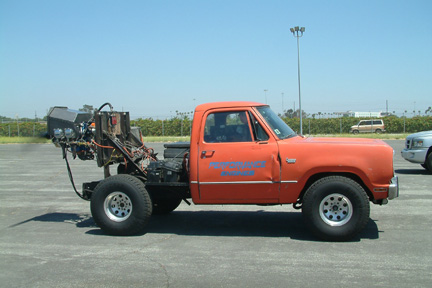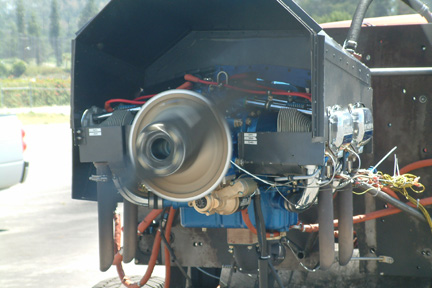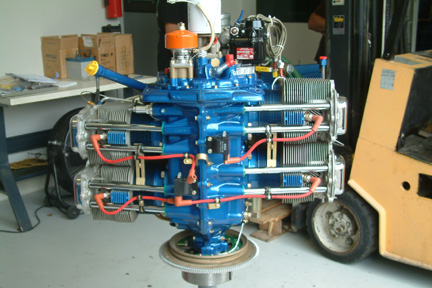Chapter
23 - Section 1
Engine
Mount Installation
Engine
Selection
My
knowledge on aircraft engines is limited. So when it comes to engine selection, I
was a bit lost. I took time to search through the internet as well as talking to
many Cozy builders and fliers to help me make a good choice for my
engine.
Other
than auto conversion, most builders chose an IO360 instead of an IO320 (though
Nat recommended the IO320 in his newsletters). While learning the do's and
don'ts from various Cozy builders, I received a quotation from Performance
Engines out of La Verne, CA for a Stage III engine overhaul IO320 with
verifiable 185HP with his dynamometer. Though I do not quite understand what
they do to achieve the higher HP, the idea is certainly inviting... Generally,
an IO320 is about 40 lbs lighter that an IO360 (~180-200HP). My wife and I weigh
about 300 lbs (together). I think a lighter engine would be good for us because
I can potentially reduce another ~13 lbs of ballast up front - resulting in a total
53 lbs overall weight reduction yet performing at the lower HP range of a 360.
This sounds like a great option, however, I am concerned only because I have not
heard of this configuration before. Upon checking, Performance Engines is a very
reputable company and I have no reason to doubt their capabilities.
Here's
some details on what they will do: Stage III engine overhaul includes the
following: Crankcase: lapped and aligned bored, visual inspection for
dimensional and structural integrity and NDT tested. The crankshaft: Magnafluxed,
measured for size, reground and heat tested if necessary. Rod and main bearings
replaced. Four cylinder assemblies installed. New 10:1 forged pistons. All
stress fasteners replaced. Connecting rods rebushed and checked for
straightness. Camshaft and lifters are replaced with new. All necessary ferrous
and nonferrous parts are NDT tested. Rocker arms are rebushed and ratioed. All
aluminum parts are coated with gold irodite and engine is painted in 3 part
Epoxy in choice of color. All fasteners are cad plated gold and valve covers,
push tubes and intake tubes chrome plated. Accessories included are; Single
Lightspeed Plasma III CDI electronic ignition kit + single Slick magneto with
plugs & wires (new), B&C high torque starter (new), B&C alternator
12v 60amp (new), FM-200A fuel servo (new) rear facing induction system, fuel
flow divider (new), 4 fuel nozzles (new), fuel pump (ovh). Engine functionally
tested and tuned for 3.5 hrs., then preserved & crated for shipment.
Delivery time 2-3 months. Performance Engines is
about 10 miles from me which gives me a bit of a comfort when its time to
install the engine. Its warranty does not start until my first flight and is
covered for 4 years prorated at 40 hours per month.
I
posted a question to the Cozy group and did not get any negative comments to my
post, though a couple people still recommended a IO360. I decided to stick with
Performance Engines and ordered the engine in August 2009.
 After
almost 10 months and with a bit of pushing, my engine finally got assembled. Per contract requirement,
Performance Engines ran the engine for 3.5 hours on July 2, 2010. Some tuning
and adjustment were made during that time. Ron Munson (the owner of Performance
Engines) invited me to witness the test run (if I was interested). I drove over
to the airport and watched him run the engine with a Club propeller. Supposedly,
the Club propeller was designed to apply load to the engine (160HP @2,200
rpm). Ron ran the engine from 600 rpm up to 2,400+ rpm while taking engine
performance data at 15 minute intervals. The plaque on my engine is rated at 185HP
@ 2,700
rpm. I need to learn how he came to that conclusion / rating. I think this is
important when buying the propeller down the road.
After
almost 10 months and with a bit of pushing, my engine finally got assembled. Per contract requirement,
Performance Engines ran the engine for 3.5 hours on July 2, 2010. Some tuning
and adjustment were made during that time. Ron Munson (the owner of Performance
Engines) invited me to witness the test run (if I was interested). I drove over
to the airport and watched him run the engine with a Club propeller. Supposedly,
the Club propeller was designed to apply load to the engine (160HP @2,200
rpm). Ron ran the engine from 600 rpm up to 2,400+ rpm while taking engine
performance data at 15 minute intervals. The plaque on my engine is rated at 185HP
@ 2,700
rpm. I need to learn how he came to that conclusion / rating. I think this is
important when buying the propeller down the road. Here's another picture of my engine during its 3.5 hours
run time. It's loud!
Here's another picture of my engine during its 3.5 hours
run time. It's loud!